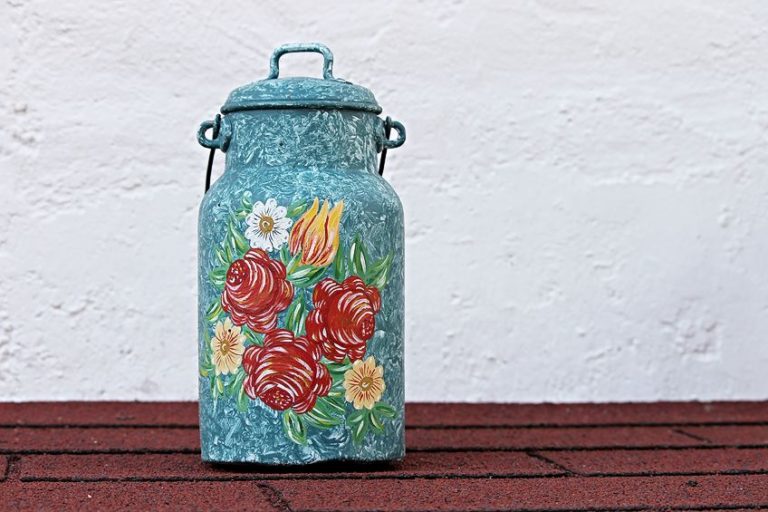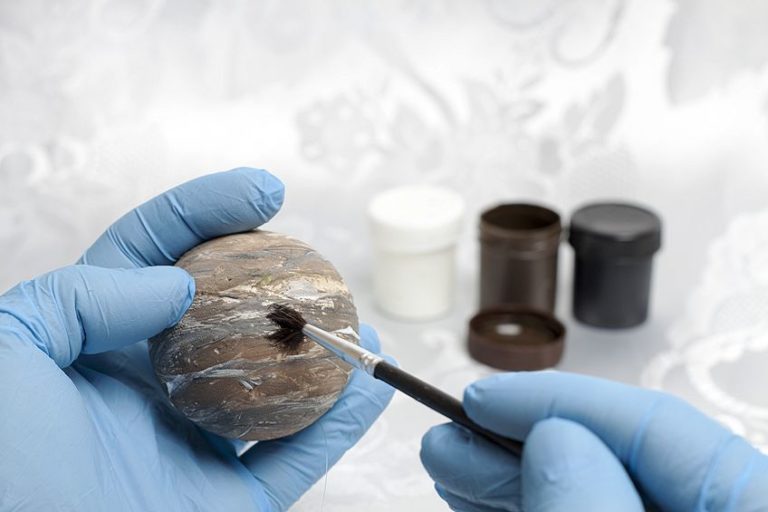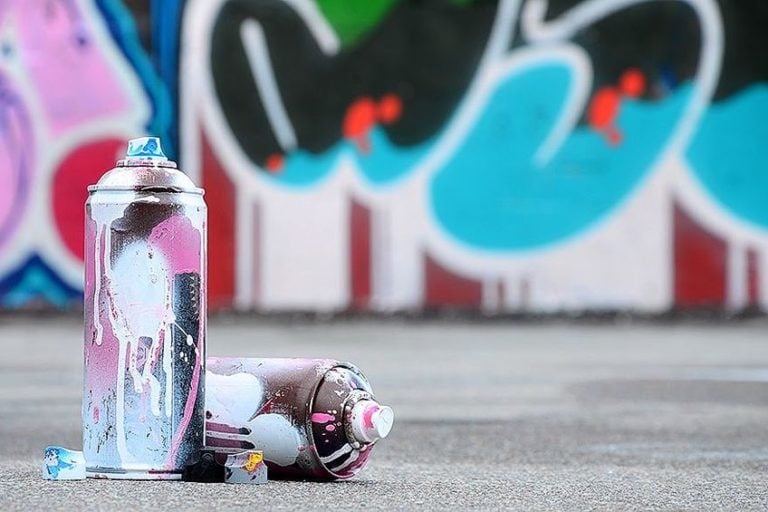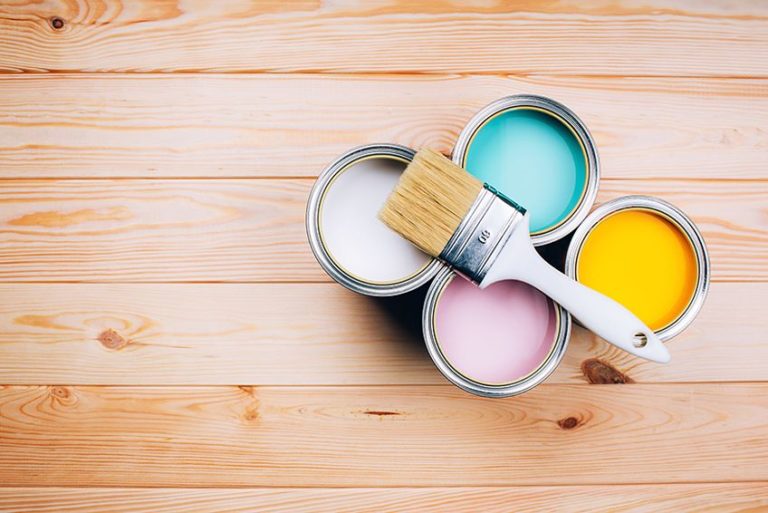How to Clean Paint Brushes – A Guide on How to Clean Old Paint Brushes
This post may contain affiliate links. We may earn a small commission from purchases made through them, at no additional cost to you.
At some point, we have all left the paint to dry into the very fibers of a paint brush and then tried desperately to make amends later, often without success. While we all know that cleaning our brushes after use is essential, we are also human. If you do not know how to clean paint brushes, you have come to the right place. In this short tutorial, we will provide you with a guide to removing paint from your paint brushes to save you some money and heartache.
Table of Contents
Why Is It So Important to Clean Paint Brushes?
As with all painting supplies, paint brushes range in quality and price. If you are a professional artist, you may have some more expensive paint brushes in your collection, and you need to look after them, which includes knowing how to remove dried paint from brushes you have left sitting. Although we are strong advocates for learning how to wash paint brushes immediately after use, we will also guide you through how to get dried paint out of paint brushes.
Paint brushes become damaged in two primary ways. The first way our brushes can become damaged is by the way we use them. The other way we can damage our paint brushes is by washing and storing them incorrectly.
Using a loved paint brush until it has no bristles left is like a loved-one dying of old age. This paint brush death is extremely upsetting but to be expected at some point. Losing your favorite brush before its time because you failed to look after it properly is far more devastating.
If you continuously fail to clean your brushes properly, you will have to replace them faster, costing you unnecessary money. You need to know how to remove dried paint from brushes so that you do not have to keep buying new ones. Knowing how to clean a paint brush correctly after each use will keep them sleek and pristine for longer and save you money too.
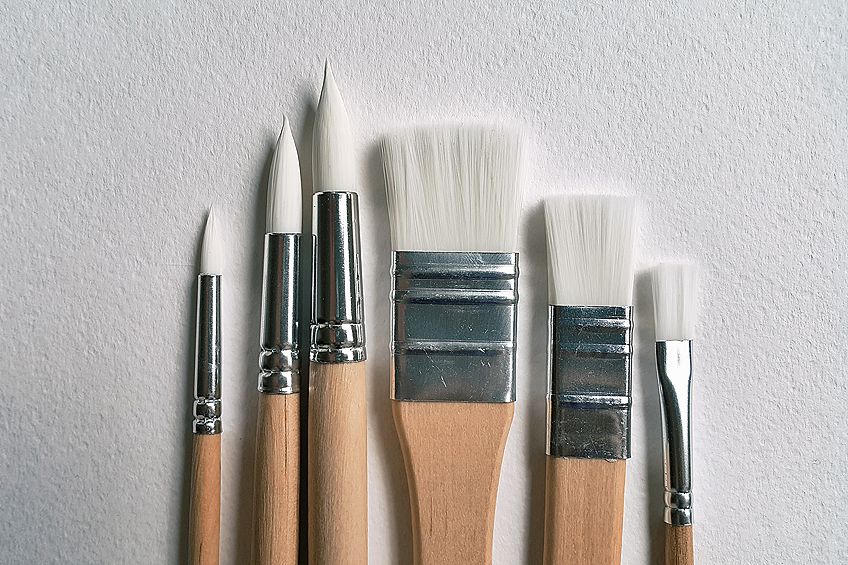
The Anatomy of a Paint Brush
A paint brush is more than the bristles, and you need to know how to care for each part of it properly. Each bit of the paint brush is essential to its functioning. Here are the three main elements of a paint brush, what it does, and why it is vital to clean them properly.
| Brush Part | What it does | How to Care for it |
| Bristles | Depending on the quality of your paint brush, you may have natural or synthetic bristles. The bristles are the main action center of any paint brush because they pick up and deposit the paint. | Caring for your bristles is absolutely essential. It may seem like the most obvious advice, but you need to clean any paint from the bristles immediately after each use. Not only can old paint destroy the integrity and flexibility of your bristles, but you may also experience unwanted colors seeping into your next project. |
| Ferrule | The ferrule is another important part of the paint brush because it connects the bristles to the handle. The ferrule holds the bristles to the handle with glue and crimped ends. | The most important care you can give your ferrule is to ensure it is dry after cleaning. Any water that remains around the ferrule can seep under the metal and dissolve the glue, causing the handle to rot and the bristles to fall out. |
| Handle | The handle of your paint brush can either be made of plastic or wood. | The handle is the easiest part of the brush to care for because all you need to do is wipe off any paint and ensure that it is dry before storing. |
How to Clean Paint Brushes
The most important thing you can take from this tutorial is this: Do not wait to clean your paint brushes! Not only do you risk causing your brush damage if you let the paint dry on it, but it is so much easier to clean them immediately. While we understand that the transition from the creative space to cleaning up is never fun, your future self will thank you for taking the time to clean your brushes as soon as you finish using them.

How to Wash Paint Brushes with Soap and Water
If you paint with acrylic or watercolor paints, cleaning your brushes after use is very easy. The ease of cleaning these paints from your brushes is just one less excuse you have not to do it. All you need to clean water-based paints from your beloved paint brushes is water and soap. It is up to you what kind of soap you use. Some artists swear by regular dishwashing soap, while others prefer to use specialized brush-cleaning soaps.
If you are serious about painting and caring for your brushes, we do suggest that you get a brush cleaning soap. Specially formulated art soaps provide the best care to every part of your paint brush, so they last for as long as possible. After the cleaning tutorial, we will give you our recommendations for the best brush cleaning soaps.
How to Clean Paint Brushes with Soap
As soon as you have finished your painting, you need to start the cleaning process. It is quick and simple, and once you get into the habit, you will barely notice that you are going through the motions.
- The first step takes place at your workstation. Before you even stand up, place the bristles of your paint brushes between a rag and use this to squeeze out any excess paint and water. You can use paper towels too, but using a rag is much more environmentally friendly and ultimately more affordable.
- Once you have squeezed out any excess paint, gently swirl your paint brush around in some water. This second step also releases any final bits of wet paint from the bristles. Carefully shake the water from your brush and pat it dry on a towel or rag.
- You can repeat the first two steps until you have removed the bulk of the paint.
- Now it is time to go to the sink. We suggest placing a bucket or container below the tap to catch the water you are about to use. The chemicals in paints like acrylic damage the environment, so it is best to prevent any from going down your drain.
- Carefully rinse the paint from your paint brush under lukewarm water. Use your fingers to part and squeeze the bristles to dislodge any paint that is still clinging on. For reasons of environmental friendliness, it is best to work quickly under a small stream of water.
- Now it is time to get out your soap. Put a small amount of soap on your brush and use your fingers to wash the bristles gently.
- Make sure that you have rinsed the bristles thoroughly so that they are not holding onto any more soap.
- If there is any paint left in the bristles of your paint brush, you can repeat the last few steps.
- When you are happy with your clean brush, shake out any excess water. Pick up your rag again, lay the bristles between the layers, and squeeze out the remaining water.
- Let your brush dry slowly in a safe place. It is best to lay it down horizontally to dry so that any remaining water does not trickle down into the ferrule.

Our Recommendations for Artist Soaps
While you can use regular dishwashing soap to wash your brushes, there is no denying that an artist soap will protect and care for your paint brushes more. The great thing about these artists’ soaps is that you can use them to remove acrylic, watercolor, and oil paints from your brushes. If you are a multi-media painter, you will definitely appreciate a soap that will clean all of your paint brushes.
While these soaps are pricier than regular soap or dishwashing soap, they last for a very long time. Also, if you are using cheap soap that is damaging your brushes, you are likely to spend more money replacing them in the long run.
Premium Pick: PINK SOAP Artist Brush Cleaner
Among artists, the Pink Soap brush cleaner is one of the most popular products for cleaning paint brushes. There are many things to love about this soap, including its versatility, conditioner, and lack of harsh chemicals.You can use this Pink Soap to clean any paint from your beloved brushes, even oil paint, which is the most stubborn. Some artists have even stated that they use this soap to clean things like car grease and other stubborn stains from their hands and clothes.
Given the strength of this soap, you may expect it to contain harsh chemicals, but it is actually solvent- and alcohol-free, and it contains no phosphates, alkalis, or chlorides. The Pink Soap is also kind to your paint brushes – it includes a conditioner that leaves your bristles feeling soft and silky, but not greasy.
- The ideal brush cleaner for cleaning oils, acrylics, and watercolors
- Contains a conditioner; leaves no greasy after-feel
- Contains no chlorides, alkalis, phosphates, solvents, or alcohol
PROS
- Free from harsh chemicals
- Conditioner leaves bristles soft and pliable
- Very effective
- Versatile
CONS
- Only available in an eight-ounce bottle
Value for Money: GENERAL PENCIL COMPANY INC. “The Masters” Brush Cleaner and Preserver
There is a reason that artists everywhere rave about this product. Not only does this cleaner remove all traces of oil, acrylic, and watercolor paint immediately after use, but you can also use it to remove dry paint from forgotten brushes. If you want the ultimate brush cleaning and care product, look no further than this cleaner and preserver.
You can also use this soap to remove stubborn stains on the bristles of your paint brushes. The conditioner and preserver in this soap keep your paint brush bristles supple and silky smooth. Not only is it incredibly effective, but it is also relatively affordable. Although the pot is only one-ounce, a little goes a long way, and it lasts for a long time. We can highly recommend this product to anyone who wants to give their paint brushes the ultimate care.
- Formulated for use with oils, acrylics, and watercolors
- Will even remove dried paints and paint stains from brushes
- Soap leaves behind a clean, fresh scent
PROS
- Highly effective
- Removes stubborn stains
- Removes oil, watercolor, and acrylic paint
- Removes old dry paint
- Conditions and preserves bristles
CONS
- Pot size is only one-ounce
How to Wash Paint Brushes with Fabric Softener
Using fabric softener may seem like an odd choice, but it works in much the same way as water and soap. You can use fabric softener to remove watercolor, acrylic, and oil paints from your paint brushes. To get started, you will need four cups of warm water, 1/8 of a cup of fabric softener, a bowl, and an old rag.
- Begin by removing as much of the paint from your paint brush as possible. You can rinse it in water and then use your rag to squeeze out as much paint as you can. Removing the majority of the paint at this first step will make the rest of the process much faster.
- Combine your warm water and fabric softener in your bucket, and mix it well.
- Begin gently swirling your paint brush in the softener mix. You will see paint flecks beginning to fall out and settle at the bottom of the bucket. Continue swirling your paint brush around until there is no longer any paint falling out.
- Remove any last bits of fabric softener and paint by rinsing your paint brush under cold running water.
- Using your rag, gently squeeze the last remaining water out of your brush bristles. Reshape the bristles, and leave your paint brushes to dry lying down on a flat surface.
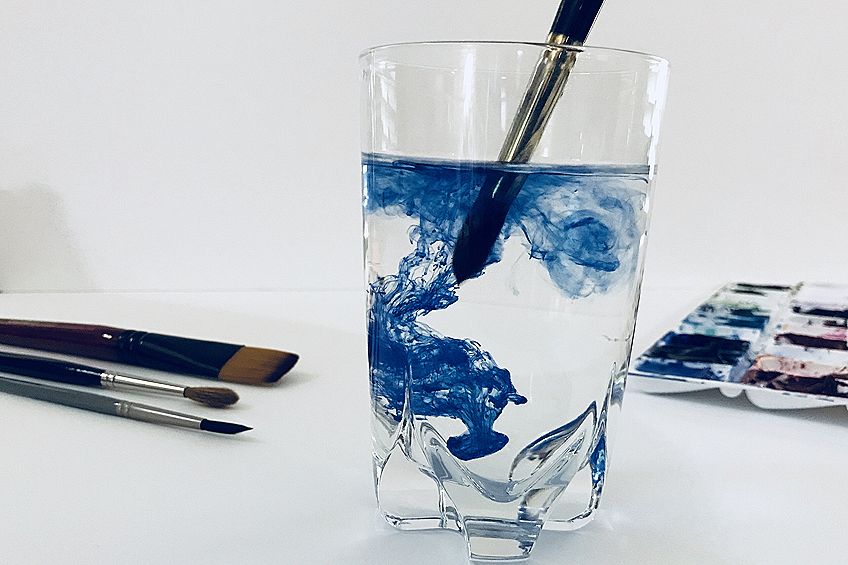
How to Clean Old Paint Brushes and Oil-Based Paints with Solvents
As you have now seen, many artist soaps are just as good for removing oil-based paints as they are for water-based paints. There is, however, another option for cleaning oil paint from your brushes. Although it is not as eco-friendly, solvents can effectively remove stubborn oil paint from your brush bristles. This method is also great if you want to know how to get dried paint out of paintbrushes.
You can use different solvents for different types of paint. Paint thinners or mineral spirits are best for paints with oil bases and varnishes, while denatured alcohol is best for shellacs. As you will be working with solvents, it is a good idea to wear some protection, like an apron and gloves. Another quick note is that paint thinners are hazardous waste products, meaning you need to dispose of them very carefully. You will need to find out and follow your city’s regulations on disposing of them.
The washing process is similar to that of using water and soap, but it deviates in several ways. You will need the appropriate solvent, an old container, a rag, and protective equipment.
- To start, try to remove as much of the paint as possible by rinsing it in water. Gently squeeze the brush bristles between your rag (or paper towel). The more paint you remove in this first step, the easier the rest of the process will be.
- Now add a small amount of solvent to your container. Dip the bristles of your paint brush into the solvent, and gently swirl it around. You will see the bristles begin to release the paint into the solvent. Continue swirling your brush gently until all the visible paint has disappeared.
- When you have removed all the paint from your brush, gently rinse the brush under running water. This step is essential in removing the solvent from the paint brush. If you do not remove the solvent, it will dry out your bristles.
- Squeeze the brush bristles between your rag again to remove the last bits of water and solvent.
- Reshape your paint brush, and leave it lying horizontally to dry.
If you want to know how to clean dried paint brushes with solvents, the process is the same, but it may take a little longer. The solvent will loosen the specks of dry paint from the bristles, and you can speed the process up by gently removing these with your fingers. Remember to wear gloves if you are going to be sticking your fingers into the solvent!
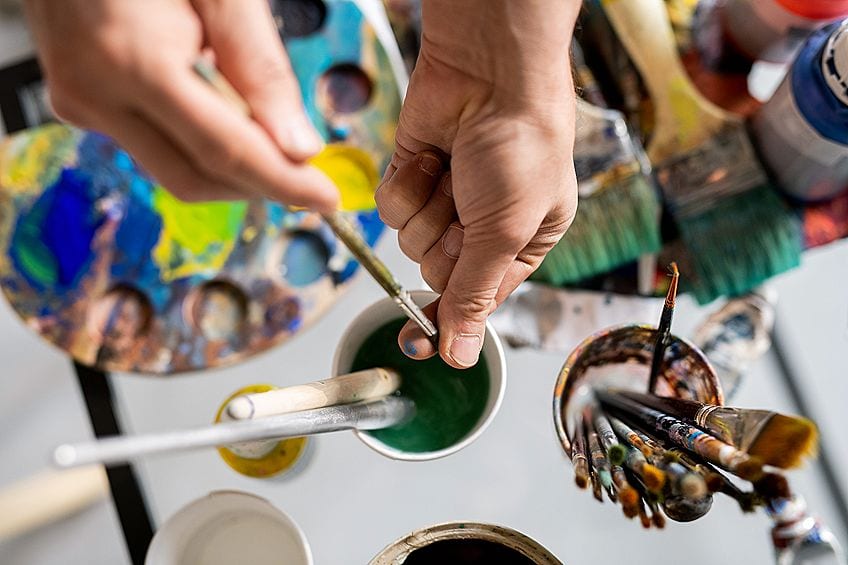
How to Clean old Paint Brushes with Vinegar
Vinegar is a fantastic option for removing old paint from a paint brush, and it is less damaging to the environment and your brushes than solvents. The process is quite laborious, but it is a great way to restore some of your forgotten paint brushes. You will need a cooking pot and white vinegar for this method.
- Pour the white vinegar into your pot and place the paint-covered parts of your brushes into it. If the vinegar does not cover the areas of your paint brush with hardened paint, add some more.
- Slowly bring the pot of vinegar and paint brushes to the boil and let it bubble for a few minutes. Your kitchen may end up smelling like nothing but vinegar, and you can reduce this by placing a lid on the pot.
- After a few minutes, remove the pot from the heat and let it sit for a few minutes to cool.
- Carefully remove the paint brushes from the vinegar. The vinegar will be extremely hot, so please take precautions.
- Gently comb the bristles of your paint brushes with your fingers. You will see little clumps of dry paint clinging to the brush bristles, and you can carefully remove these as you comb.
- Rinse the paint brush in cold running water to wash away the remaining flecks of dry paint.
- You may need to repeat the process a few times with very stubborn paint. If the paint has been sitting on the brush bristles for a very long time, the process will take even longer. Patience is key because you will get there eventually.
- Squeeze out the remaining water in your rag and reshape your brush bristles. Leave your paint brushes lying horizontally as they dry, and then store them upright.
The vinegar method is a fantastic alternative to using solvents. Many artists swear by using apple cider vinegar instead of white vinegar, so it may be worth experimenting to see what works best for you.
Other Practices to Preserve and Protect Your Paint Brushes
Even if you take the time to clean your paint brushes properly after every use, you can still damage them in other ways. Failing to store them correctly or using them in the wrong way can damage the bristles of your paint brushes, no matter how well you clean them.

Drying and Storing Your paint brushes
It is vital that you store your paint brushes properly after you have cleaned them. The method you use to keep your brushes depends on the length of time you store them for and whether they are dry or wet.
It is best to lay your brushes down horizontally on a flat surface after washing them until they are completely dry. Never place your brushes in a container bristle down, especially if they are wet, because this will cause the bristles to dry out of shape. If this happens, you do not need to panic. All you need to do to fix it is rewet the bristles, shape them with your fingers, and leave them to dry horizontally.
You should also never store wet paint brushes upright because the remaining water may run down underneath the ferrule. Water in your ferrule causes all sorts of problems, such as causing the wooden handle to swell and then shrink as it dries. This cycle will eventually cause the glue to come away from the handle. You will end up with a brush with loose bristles.
After washing your brushes, gently shape the bristles with your fingers, and leave the paint brushes to dry flat on a surface. Once your paint brushes are dry, you can store them upright without any issues. If you need to store your brushes for a long time, we recommend placing a few mothballs in the container with them to protect the bristles.
Work on Your Painting Techniques
Another way that you can damage the bristles of your paint brushes is by using them wrong. The way we use our brushes to pick up paint will directly affect their longevity. Ideally, we should only use the bottom half of the bristles to pick up the paint. You must never mix oil paints with your brush, and you should never overload your bristles with paint. If you do these things, you risk getting paint up onto the ferrule, and this can cause some problems.
When it comes to cleaning our brushes, we work the paint out of the bristles by gently flexing the hairs to release any build-up. The problem with paint up near the ferrule is that the bristle hairs become a lot less flexible the closer you get to it. As a result, particles of dry paint will build up over time, and this can spread the bristles apart and ruin the shape of the brush. The easiest way to prevent this from happening is to use a pallet knife to mix your paint and be more mindful of loading the bristles with paint.
The way we use our paint brushes on the canvas can also make or break their longevity. While some artists tend to make very light and feathery strokes with their brushes, many of us tend to scrub backward and forwards. This scrubbing motion is much more damaging for the brush bristles and can lead to breakages.
With all of this said, the way you make marks on your canvas is unique to your style. Never sacrifice your own personal artistic flair simply to keep your paint brushes in good condition. As the old adage says, if you never substitute your paint brushes, you are not creating enough.
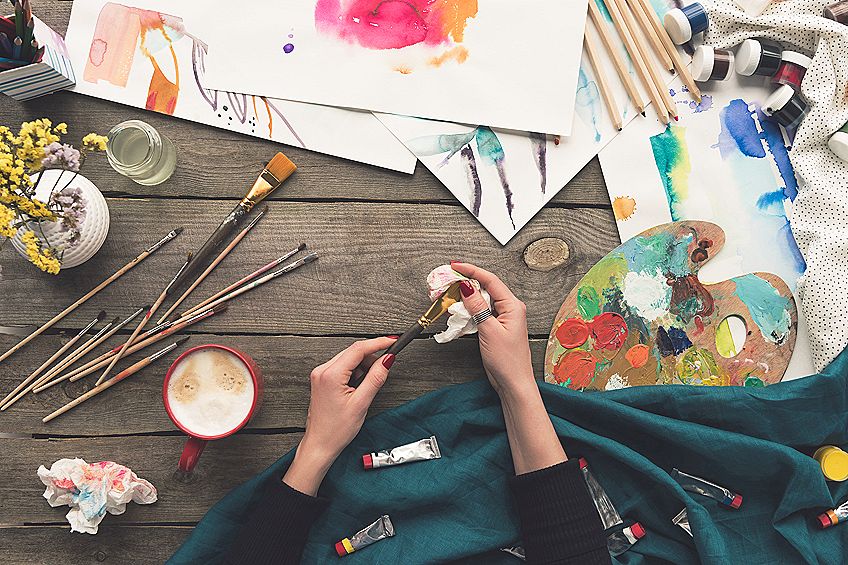
Frequently Asked Questions
How to Clean Dried Paint Brushes?
There are several methods you can use when you want to know how to remove dried paint from brushes. The best way to clean paint brushes is to use a paint brush cleaner like a specialized artist soap. You can also use solvents like paint thinners or white vinegar to clean paint brushes.
How to Clean a Paint Brush?
Cleaning your paint brushes right after use is the best way to care for them and make them last a long time. If you are working with water-soluble paints, like acrylic or watercolor, you can simply wash your paint brushes with soap and water. If you use oil paints, you may need to bust out the big guns like paint thinners and other solvents. Some people think that using fabric softener is the best way to clean paint brushes.
Should You Wash Your Paint Brushes Over the Sink?
We usually recommend that you do not use the sink when you are cleaning paint brushes because the chemicals in the paint may return to the water system. If you are using solvents or vinegar as your paint brush cleaner, you should definitely not throw this down the sink. You should also not wash acrylic paint brushes in the sink because the plastic in the paint is not good for the environment or humans.
How to Clean Old Paint Brushes with Household Items?
Vinegar is the best household item you can use as a paint brush cleaner. If you have old, crusty paint brushes and you want to know how to remove dried paint from brushes, vinegar should be your go-to product. All you need to do is boil your paint brushes in the vinegar for a few minutes, and then rinse them under the tap to remove the flakes of dry paint. The vinegar method is the best way to clean paint brushes with household items.
Larissa Meyer is a 32-year-old mother from Michigan and creative spirit since childhood. Her passion for painting and drawing has led her to an education as an illustrator and a career as a freelance graphic designer. She has a Bachelor of Fine Arts in Illustration and a degree in Graphic Design. Larissa is a talented artist who is able to master a wide range of styles and techniques to bring her artistic vision to life. Her greatest passion is currently fluid painting and epoxy resin art. Larissa’s love for art and her knowledge and experience in illustration make her the perfect Creative Director for our fluid-painting.com team. She is the creative head of our team and shares her passion and knowledge with our community through articles and tutorials.
As a mother of a 2-year-old daughter, Larissa also understands the importance of fostering creativity in early childhood. She uses her experience and knowledge to help other parents inspire their children and develop their artistic skills as well.
Learn more about Larissa Meyer and about us.





